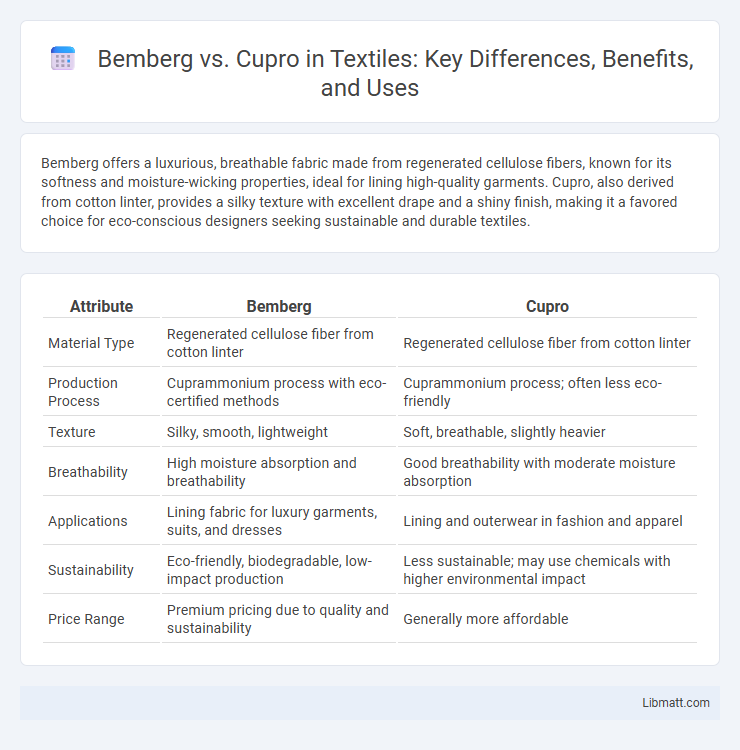Bemberg offers a luxurious, breathable fabric made from regenerated cellulose fibers, known for its softness and moisture-wicking properties, ideal for lining high-quality garments. Cupro, also derived from cotton linter, provides a silky texture with excellent drape and a shiny finish, making it a favored choice for eco-conscious designers seeking sustainable and durable textiles.
Table of Comparison
| Attribute | Bemberg | Cupro |
|---|---|---|
| Material Type | Regenerated cellulose fiber from cotton linter | Regenerated cellulose fiber from cotton linter |
| Production Process | Cuprammonium process with eco-certified methods | Cuprammonium process; often less eco-friendly |
| Texture | Silky, smooth, lightweight | Soft, breathable, slightly heavier |
| Breathability | High moisture absorption and breathability | Good breathability with moderate moisture absorption |
| Applications | Lining fabric for luxury garments, suits, and dresses | Lining and outerwear in fashion and apparel |
| Sustainability | Eco-friendly, biodegradable, low-impact production | Less sustainable; may use chemicals with higher environmental impact |
| Price Range | Premium pricing due to quality and sustainability | Generally more affordable |
Introduction to Bemberg and Cupro
Bemberg is a high-quality regenerated cellulose fiber made from cotton linter, known for its softness, breathability, and natural moisture-wicking properties, making it ideal for luxurious linings and apparel. Cupro, also a regenerated cellulose fiber derived from cotton waste, is valued for its silky texture, smooth drape, and eco-friendly production process that emphasizes sustainability. Your choice between Bemberg and Cupro depends on specific fabric needs, with both offering premium comfort and environmental benefits.
Origins and History of Bemberg and Cupro
Bemberg is a branded form of cupro, originally developed in the early 20th century by the Japanese company Asahi Kasei as a regenerated cellulose fiber derived from cotton linter. Cupro, short for cuprammonium rayon, has its roots in 1890s Germany, created through a chemical process involving copper and ammonia to dissolve cellulose from cotton waste. Your choice between Bemberg and traditional cupro can reflect the evolution of sustainable textile innovations spanning over a century.
Raw Materials and Manufacturing Processes
Bemberg is derived from regenerated cotton linter fibers, a byproduct of cotton production, using a closed-loop manufacturing process that recycles solvents, ensuring eco-friendly production. Cupro, on the other hand, is made from cotton waste and utilizes copper-based solvents in its production, which also follows a regenerative process but differs chemically from Bemberg's amide solvent system. Your choice between Bemberg and Cupro may depend on preferences for specific raw materials and sustainable manufacturing practices in textile production.
Environmental Impact and Sustainability
Bemberg, made from regenerated cellulose derived from cotton linter, features a closed-loop production process that recycles over 98% of chemicals and water, significantly reducing environmental pollution compared to conventional fibers. Cupro, also a regenerated cellulose fabric from cotton waste, involves a similar recycling system but generally requires more energy and water consumption during production. Both fibers offer biodegradability and lower ecological footprints than synthetic alternatives, but Bemberg's advanced closed-loop technology positions it as a more sustainable choice in terms of water usage and chemical recovery.
Texture and Feel: Comparing Bemberg vs Cupro
Bemberg offers a smooth, soft texture with a lightweight, breathable feel, making it ideal for luxurious linings and summer garments. Cupro features a silk-like, crisp texture that drapes elegantly while maintaining breathability and moisture-wicking properties. Both fibers excel in comfort and sophistication, but Bemberg tends to feel softer against the skin, whereas Cupro provides a slightly firmer hand and sheen.
Performance and Durability
Bemberg excels in moisture management and breathability, making it highly durable for garments requiring repeated wear and laundering. Cupro offers a silk-like texture with strong tensile strength, providing excellent longevity and resistance to pilling. Both fibers perform well under stress, but Bemberg's superior moisture wicking enhances its durability in active or humid conditions.
Common Uses in Fashion and Textiles
Bemberg is widely favored for luxury linings and lightweight garments due to its smooth texture and breathability. Cupro, often used in high-end blouses and dresses, offers a silky feel with better durability and wrinkle resistance. Your choice between Bemberg and Cupro can significantly impact the comfort and drape of fashion pieces.
Care and Maintenance Differences
Bemberg fabric requires delicate care, ideally hand-washing with mild detergent and air drying to maintain its softness and sustain breathability. Cupro, while also delicate, can often tolerate gentle machine washing on a cold cycle but should be kept away from high heat in drying to prevent shrinkage or damage. Understanding these subtle care differences helps preserve the luxurious texture of your garments and extends their lifespan significantly.
Cost and Market Availability
Bemberg, derived from regenerated cellulose fibers, tends to be more costly due to its complex production process and premium positioning in the market, often found in high-end fashion and luxury linings. Cupro, also a regenerated cellulose fabric but made from cotton linter, generally offers a more affordable price point and broader availability across various textile markets. Your choice between Bemberg and Cupro will depend on budget constraints and the specific demand for sustainable or luxury materials in your production or wardrobe.
Choosing Between Bemberg and Cupro
Choosing between Bemberg and Cupro depends on desired fabric properties and sustainability goals. Bemberg, a brand of regenerated cupro made from cotton linter, offers superior breathability, moisture-wicking, and a silky texture ideal for luxury linings and delicate garments. Cupro, also derived from cotton waste, provides a sustainable, biodegradable alternative with similar softness and drape, making it a versatile choice for eco-conscious fashion designers seeking high-performance, eco-friendly textiles.
Bemberg vs Cupro Infographic

 libmatt.com
libmatt.com